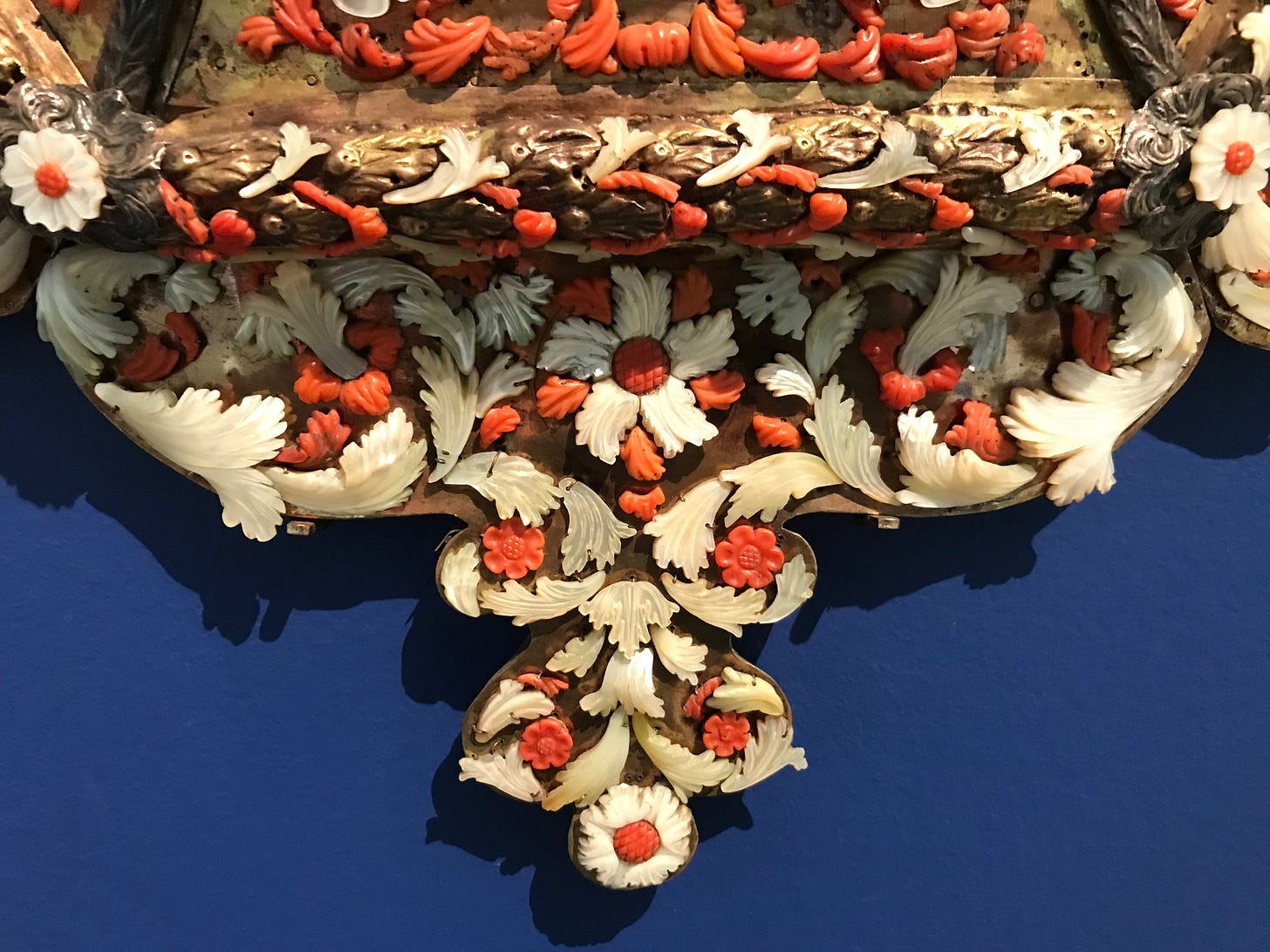The Flimsy History of Red Coral
Humans make up origin stories for other species that can have damaging effects
I really want to write based on facts.
The deep-blue Naples gallery at Compton Verney houses three pieces of Trapani red coral decoration—a Nativity scene, a frame, and a box (from 1700 to 1750). This is a fact. I went there and took photos of the red coral pieces.
FIRST MISLEADING IDEA
The placard beside the red coral frame reads: “Red Mediterranean coral grew in abundance off the Italian coast and Trapani in Sicily became a leading centre of coral craftsmanship from the fifteenth to the eighteenth century.” If I had not read this, I would have assumed this piece was made in Naples because it was in the Naples gallery. How do we know that Trapani specialized in coral craft and why did it end in the eighteenth century? On whose authority do we know this? This fact needs more research.
“According to the Christian tradition coral symbolized the blood of Christ and was believed to ward off evil, with coral bracelets, talismans and decorative items becoming popular souvenirs.” This Christian tradition does not appear to have carried over to the twenty-first century. So, when was this tradition widely held and are red coral souvenirs still being sold in Trapani? Trip Advisor has contradictory information; I would need to visit Trapani to see for myself whether such souvenirs exist.
SECOND MISLEADING IDEA
The second misleading idea was produced entirely by my own mind (and likely the first one as well). The placard for the box explains that it contains a secret compartment that may have been used to store important documents (maybe a love letter) or jewels. I imagined that the secret compartment was in the bottom of the box. Somehow, this hypothesis gained the status of fact in my mind, and my curiosity about the box dissipated.
As I was walking away, the docent approached me. On a previous visit, she had asked me if I had the Bloomberg Connects app, a free guide to museums and galleries. I told her I would download it, then promptly forgot. This time there was no escaping. “Have you downloaded the Bloomberg Connects app?” “Er, I’ll do it right now.” I took out my phone and installed the app under her watchful eye.
The app included a video of the curator opening the red coral box. When opened, I could see that it was lined with red velvet. Then turning the lock, she revealed the shallow secret compartment lined with gold velvet that was hidden within the lid. My hypothesis was completely wrong.
THIRD MISLEADING IDEA
There was a suggestion on Trip Advisor that wearing coral jewelry was offensive (like wearing a fur coat) because of its endangered situation. Is this a fact? There is no agreement on this. Just because some corals are endangered, we cannot assume that every type of coral is at risk. Or perhaps we should assume that every natural resource that can turn a profit is endangered. Will red coral disappear entirely like the 200-foot sand dune on the shore of Lake Michigan (the Hoosier Slide) that was levelled to the ground to make pale blue Ball jars?
According to Breken Branstrator at nationaljeweler.com, the jewelry trade “defines ‘precious’ corals as those used in jewelry that belong to one taxonomical group: the Corallidae family.”1 Coral is regulated by national law, European Union regulation, and (to the limited degree that any convention can regulate, meaning there is typically no effective way to enforce an international treaty) under the Convention on International Trade in Endangered Species of Wild Fauna and Flora. She writes that certain types of red coral are not considered endangered. Can the jewelers be trusted to state the facts? Is red coral being harvested at a sustainable rate? And how fast does that coral grow?
Chat GPT located ten scientific papers that supported the idea that precious coral species are not necessarily endangered because they are found in deep water but argued that they need to be monitored and managed to avoid overharvesting. Likewise, it found ten scientific papers taking the opposite position that they are endangered. That sounds about right. But how reliable is Chat GPT? Does the free version automatically limit its findings to ten papers? Maybe there are one hundred papers saying that it is endangered and just ten saying it is not.
National Geographic says red coral is endangered. Does that tip the balance?
OVERLY GENERALIZED INFORMATION
I need to know where the information comes from.
Various web posts agree on the basic story about red coral decoration. They list no specific sources, so are they copying each other? Are they using Wikipedia?2
The common elements include:
A myth from Ovid’s Metamorphoses, Book IV, wherein Perseus sets Medusa’s severed head on soft twigs that grow in the water. At the touch, the seaweed turns blood red and petrifies into red coral.
Various pronouncements from Pliny, such as, red coral protects the wearer from lightning and would-be seducers, that the Gauls decorated their swords and armor with it, and that much of the red coral was sent to India.
Descriptions of Romans putting red coral bracelets and pendants on their children to protect them from sickness and evil.
An account by a 12th-century Arab traveller Al-Idrisi of the high-quality red material in Trapani (no mention of the title of the work where this information is found).
Stories about how the discovery of reefs between 1416 and 1418 in Trapani led to the immigration of Jewish families of the Maghreb who contributed to the processing and commercialization of red coral.
I do not trust any of these web articles because the sources given do not contain enough information for me to find, for example, where Pliny said these things. And how reliable is Pliny (a subject of academic debate)?
However, one article said that “by 1600, fleets of special coral boats called coralline sailed daily from Naples and the port of Torre del Greco to satisfy this increasing demand for carved cameos and corals.”3 This (sort of) explained why the Sicilian artifacts were in the Naples gallery (my first misleading idea).
TRADITIONAL RESEARCH
I chose one academic source for facts about red coral: Andrew W. Bruckner, “Advances in Management of Precious Corals to Address Unsustainable and Destructive Harvest Techniques,” in The Cnidaria, Past, Present and Future: The World of Medusa and Her Sisters, edited by Steffano Goffredo and Zvy Dubinsky (Springer, 2016).
The first surprise is that red coral has been used since prehistoric times, something not mentioned in the web articles. “One of the oldest pieces of engraved red coral, believed to be a talisman, was found in Neolithic tombs of Grotta dei Piccioni in Bolognano, Italy” (p. 755).
Ovid’s story of Perseus and Medusa as presented in the web articles omits a crucial piece of information: “The legend also states that Perseus gave Medusa’s head to the goddess Athena, who used it as a shield against her enemies, possibly explaining why red coral talismans were used for protection (Tsounis et al. 2010).” Wait, let me get this straight. Millions of marine organisms have died because an ancient poet made up an origin story that imputed magical protective powers to red coral.
Now we fall into the deep waters of academic research. Where did Tsounis et al. 2010 get this information? When I read Georgios Tsounis et al., “The Exploitation and Conservation of Precious Corals,” Oceanography and Marine Biology: An Annual Review (2010) 48: 161–212, I realized that Bruckner’s article relies heavily on Tsounis et al. with some of additional sources. Tsounis et al.’s article is more detailed than Bruckner’s. They write, “Greek mythology originally elevated red coral to magical status” (p. 174) and provide several pages of detailed information about the historical use of red coral. “The Romans ingested and applied coral powder as an antidote to poison, a cure against stings, comfort for fainting spirits, to counteract fascinations, to protect humans against sorcery, to purify the blood and to cure imbecility of the soul, melancholy, mania and other maladies. Protection against the shade of satan is attributed to red coral in Christian cultures; in various other religions, it is a protector against the evil eye and any misfortune (Tescione 1973, Wells 1983).” So, I still do not know the source of this information.
Tescione 1973 is a book: G. Tescione, The Italians and Their Coral Fishing (Naples: Fausto Fiorentino, 1973). If I want to find out where this information came from, I will now need to find a copy of Tescione’s book. Given that the book is fifty-one years old, I am slightly worried that many academic libraries will have purged this book. The librarians might assume that it is now outdated and that more recent publications will be more accurate, not realizing that recent publications are citing it as a source. It is likely the recent authors have no clue where the information really originated—they are just citing trusted secondary sources, not looking at the primary source. Likewise, I was not able to locate a copy of S. Wells, Precious Corals Commercially Threatened: Invertebrate Red Data Book (IUCN, 1983).
END OF STORY
There are hints that renewed interest in coral craftsmanship may be putting precious corals at risk, something that we should take seriously.
But personally, I have no confidence that I have presented an entirely accurate account of red coral, or that it is even possible to do so. At best, this is a bit of experimental history on behalf of a species that has no way of defending itself.
Breken Branstrator, “Five Things to Know About . . . Coral,” https://nationaljeweler.com/articles/9973-5-things-to-know-about-coral, July 12, 2021.
https://www.coralliepreziosi.it/trapani-citta-dei-coralli/?lang=en
https://italoamericano.org/corallo-di-trapani/
https://preciousearth.in/blogs/gem-guides/a-guide-to-red-corals-moonga
https://en.wikisource.org/wiki/1911_Encyclop%C3%A6dia_Britannica/Coral
https://www.ft.com/content/1f173702-3183-4384-bbbc-8e37eb2b4f8b
Laura Morelli, “Italian Coral and Cameos: A History,” https://lauramorelli.com/italian-coral-and-cameos-a-history/.




